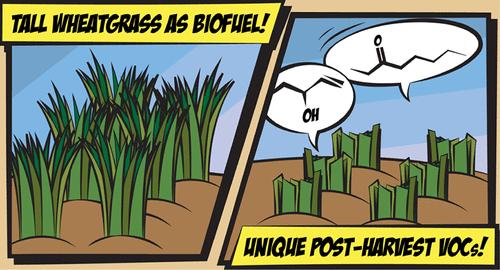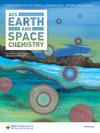Harvest Initiated Volatile Organic Compound Emissions from In-Field Tall Wheatgrass
IF 2.9
3区 化学
Q2 CHEMISTRY, MULTIDISCIPLINARY
引用次数: 0
Abstract
While crop and grassland usage continues to increase, the full diversity of plant-specific volatile organic compounds (VOCs) emitted from these ecosystems, including their implications for atmospheric chemistry and carbon cycling, remains poorly understood. It is particularly important to investigate VOCs in the context of potential biofuels: aside from the implications of large-scale land use, harvest may shift both the flux and speciation of emitted VOCs. To this point, we evaluate the diversity of VOCs emitted both pre and postharvest from “Alkar” tall wheatgrass (Thinopyrum ponticum), a candidate biofuel that exhibits greater tolerance to frost and saline land compared to other grass varieties. Mature plants grown under field conditions (n = 6) were sampled for VOCs both pre- and postharvest (October 2022). Via hierarchical clustering of emitted VOCs from each plant, we observe distinct “volatilomes” (diversity of VOCs) specific to the pre- and postharvest conditions despite plant-to-plant variability. In total, 50 VOCs were found to be unique to the postharvest tall wheatgrass volatilome, and these unique VOCs constituted a significant portion (26%) of total postharvest signal. While green leaf volatiles (GLVs) dominate the speciation of postharvest emissions (e.g., 54% of unique postharvest VOC signal was due to 1-penten-3-ol), we demonstrate novel postharvest VOCs from tall wheatgrass that are under characterized in the context of carbon cycling and atmospheric chemistry (e.g., 3-octanone). Continuing evaluations will quantitatively investigate tall wheatgrass VOC fluxes, better informing the feasibility and environmental impact of tall wheatgrass as a biofuel.

田间高麦草收割引发的挥发性有机化合物排放
虽然农作物和草地的使用量不断增加,但人们对这些生态系统排放的植物特有挥发性有机化合物(VOCs)的多样性,包括它们对大气化学和碳循环的影响,仍然知之甚少。研究潜在生物燃料背景下的挥发性有机化合物尤为重要:除了大规模土地利用的影响外,收获可能会改变排放的挥发性有机化合物的通量和种类。为此,我们评估了 "阿尔卡 "高杆小麦草(Thinopyrum ponticum)在收获前后排放的挥发性有机化合物的多样性,这种候选生物燃料与其他草种相比对霜冻和盐碱地具有更强的耐受性。在田间条件下生长的成熟植株(n = 6)在收获前和收获后(2022 年 10 月)都进行了挥发性有机化合物采样。通过对每株植物释放的挥发性有机化合物进行分层聚类,我们观察到了收割前和收割后条件下特有的独特 "挥发性体"(挥发性有机化合物的多样性),尽管植物与植物之间存在差异。在收获后的高麦草挥发性有机化合物中,总共发现了 50 种独特的挥发性有机化合物,这些独特的挥发性有机化合物占收获后总信号的很大一部分(26%)。虽然绿叶挥发性有机化合物(GLVs)在收获后排放的标本中占主导地位(例如,54% 的独特收获后挥发性有机化合物信号来自 1-戊烯-3-醇),但我们从高杆麦草中发现了新的收获后挥发性有机化合物,这些挥发性有机化合物在碳循环和大气化学方面的特征尚不明显(例如 3-辛酮)。继续进行的评估将对高杆小麦草挥发性有机化合物通量进行定量研究,从而更好地了解高杆小麦草作为生物燃料的可行性和对环境的影响。
本文章由计算机程序翻译,如有差异,请以英文原文为准。
求助全文
约1分钟内获得全文
求助全文
来源期刊

ACS Earth and Space Chemistry
Earth and Planetary Sciences-Geochemistry and Petrology
CiteScore
5.30
自引率
11.80%
发文量
249
期刊介绍:
The scope of ACS Earth and Space Chemistry includes the application of analytical, experimental and theoretical chemistry to investigate research questions relevant to the Earth and Space. The journal encompasses the highly interdisciplinary nature of research in this area, while emphasizing chemistry and chemical research tools as the unifying theme. The journal publishes broadly in the domains of high- and low-temperature geochemistry, atmospheric chemistry, marine chemistry, planetary chemistry, astrochemistry, and analytical geochemistry. ACS Earth and Space Chemistry publishes Articles, Letters, Reviews, and Features to provide flexible formats to readily communicate all aspects of research in these fields.
 求助内容:
求助内容: 应助结果提醒方式:
应助结果提醒方式:


